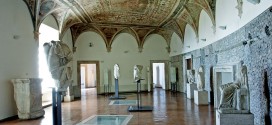When it comes to ancient temples, imagination usually runs to Greek buildings, characterized by white marble arcades surrounding a cell and supporting triangular roofs decorated by famous sculpted pediments. This type of building, in fact, present in the Greek colonies in Italy since 7th century BC, spreads at Rome and amonge italic populations starting from 2nd century BC. Before that time, namely from 6th century BC, the Italic/Roman temple had different characteristics from the Greek one. It was a tall Pedestal/base topped by tuff or limestone columns, often plastered and colourful, surrounding a cell or three central cells and supporting wooden entablature covered with clay tiles.
The beams were coated with clay slabs decorated in relief and very colorful, whose task was to protect the wood from weathering and to embellish the building.
Many of these items are kept in the National Archaeological Museum of Palestrina.
Except for the Sanctuary of Fortuna Primigenia – representing an eclectic and original architectural solution-the ancient temples found in Palestrina, beneath the Cathedral and at Piazzale della Liberazione belonging to this type of architecture.
 Archeopalestrina Percorso archeologico di Palestrina, l'antica Praeneste
Archeopalestrina Percorso archeologico di Palestrina, l'antica Praeneste

